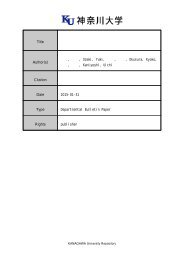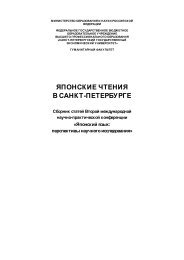to Learners with Special Educational Needs
e-textbook SEN
e-textbook SEN
Create successful ePaper yourself
Turn your PDF publications into a flip-book with our unique Google optimized e-Paper software.
Pokrivčáková, S. et al. (2015). Teaching Foreign Languages <strong>to</strong> <strong>Learners</strong> <strong>with</strong> <strong>Special</strong> <strong>Educational</strong> <strong>Needs</strong>:<br />
e-textbook for foreign language teachers. Nitra: Constantine the Philosopher University. 128 p.<br />
ISBN 978-80-558-0941-0<br />
7. Possible extension – similar activities about the British convicts who had <strong>to</strong> do a lot of<br />
work when changing Australia (using the same games and techniques)<br />
8. Memorising in groups and circular TPR activity:<br />
Learning more about Australia <strong>to</strong>day (geography) – using the map<br />
(http://fdslive.oup.com/www.oup.com/elt/general_content/global/map_posters_worksheets/A<br />
ustraliaandNewZealandMapPoster.pdf) – dividing the class in<strong>to</strong> 7 groups. Each group has <strong>to</strong><br />
memorise one text from the map of Australia, i.e. 1) the Great Barrier Reef, 2) the outback, 3)<br />
Uluru, 4) Perth, 5) Sydney, 6) Adelaide, 7) Canberra. They have 3 minutes and then they have <strong>to</strong><br />
present their text in the circle (Each student has a sentence or two). Then the teacher gives them<br />
numbers. Number 1 start in the circle, says his/her sentence, then number 2 goes in the circle,<br />
until the end of the text. This activity is very good for ending a lesson and opening the next one,<br />
as the students can look at the text again before starting the circle in the next lesson and thus reread<br />
and revise the whole text.<br />
9. Finding your pair<br />
The teacher distributes cut out sentences <strong>with</strong> the facts about Australia. Each student has<br />
only half of the sentence and they have <strong>to</strong> find the other half, i.e. their partner (see appendix 2);<br />
follow up: writing. The teacher distributes a new table (see appendix 3) <strong>with</strong> only halves of the<br />
sentences. Dyslexic learners can only paste the second halves of the sentences in the lesson and<br />
can copy the second halves at home <strong>to</strong> be provided more time for their writing practice.<br />
10. Possible extension:<br />
a) Life in the outback (a day in the life of people living in the outback)<br />
b) School in Australia (school of the air – practicing teaching using IT (skype, mp3s, emails, etc.)<br />
c) Flying doc<strong>to</strong>rs (using transmitters for listening and making notes about the problem/patient)<br />
d) The riches of Australia (planning the crops, prices, sales, economic growth)<br />
e) The current situation of the Aborigines<br />
f) More readymade teaching resources can be found on: www.oup.com/elt/gradedreaders<br />
Conclusions<br />
The objective of the chapter was <strong>to</strong> introduce drama as a multisensory, project method using<br />
acting techniques and conventions <strong>to</strong> create “as if” worlds and situations, which make foreign<br />
language learning more meaningful. After a brief introduction of drama and project method,<br />
drama in EFL, what drama can offer <strong>to</strong> SEN learners, and a list of techniques and conventions<br />
suggested by two of the big names in drama in EFL, Jonothan Neelands and Tony Good, I<br />
presented a structured drama project using some of the techniques from their list, planned in<br />
such a way that all 4 language skills were developed <strong>with</strong>in the project and also that the project<br />
fulfilled the conditions of multisensory (learning through more senses), and holistic and situated<br />
learning (learning in a complex situation via own experience <strong>to</strong> understand the <strong>to</strong>pic) <strong>with</strong> the<br />
focus on fluency and friendly atmosphere in the classroom <strong>to</strong> give all learners at their time<br />
(when the activity was easy for them-it suited their intelligence/strength) the feeling of success.<br />
I have chosen the <strong>to</strong>pical theme of immigrants, however, from a bit different point of view as,<br />
in this case, the unwanted immigrants are the British in 1788, which the students appreciated<br />
and laughed at.<br />
106






